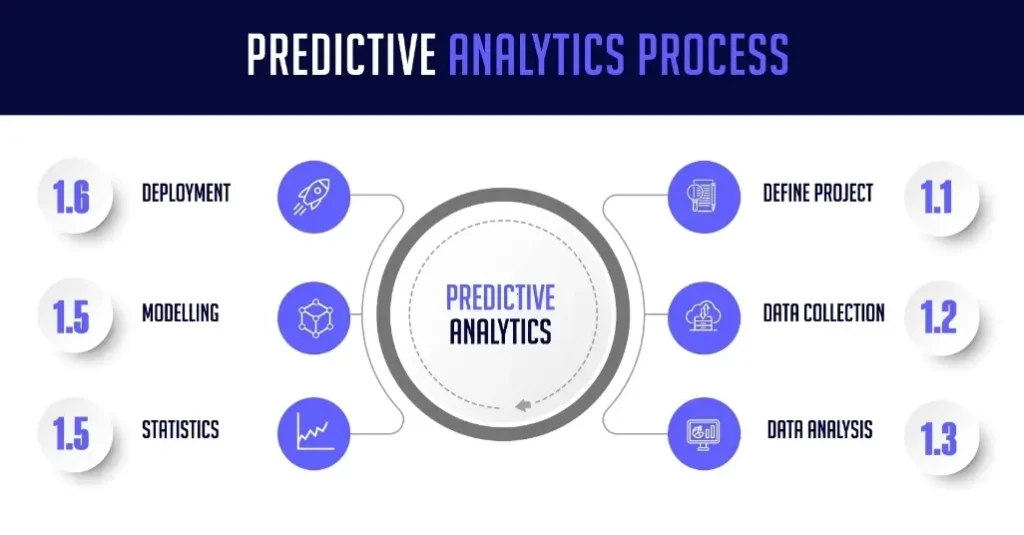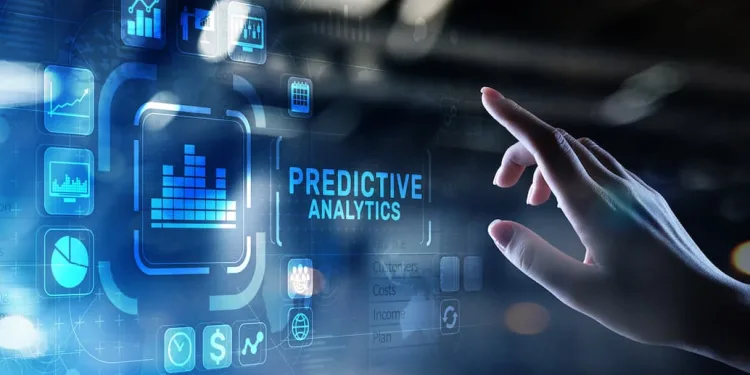In the boardrooms of today’s most successful companies, a new kind of foresight is emerging. It’s not about hunches or gut feelings, but about leveraging the power of data to peer into the future with remarkable accuracy. This power is embodied in predictive analytics, a revolutionary technology poised to transform how businesses operate.

This blog post isn’t just about the “what” of predictive analytics; we’ll delve into the “how” and the “why.” We’ll separate hype from reality, explore the core principles at play, and showcase real-world applications that demonstrate the immense potential of this technology to revolutionize various aspects of business strategy.
Beyond the Crystal Ball: Unveiling the Powerhouse Within
Predictive analytics doesn’t involve mystical pronouncements or tea leaf readings. It’s a data-driven approach that utilizes the vast trove of information businesses collect in today’s digital age. Here’s a breakdown of the magic behind the curtain:
- Data as the Fuel: The foundation of predictive analytics lies in historical data. This includes customer transactions, market trends, operational metrics, social media engagement, sensor data from equipment – the list goes on. The more comprehensive and high-quality this data is, the better the predictions will be.
- Statistical Modeling and Machine Learning: The Alchemists’ Tools: This is where the real power lies. Sophisticated statistical models and machine learning algorithms are applied to historical data. Imagine these algorithms as highly skilled analysts, meticulously sifting through the data to identify patterns and relationships between seemingly disparate variables. They learn to recognize subtle trends and correlations that might escape the human eye.
- Predicting Future Outcomes: Unveiling the Unknown: Once trained on historical data, these models can then use their newfound knowledge to predict future outcomes with a high degree of accuracy. This could involve predicting customer churn, forecasting sales figures, or even identifying potential equipment failures before they occur. Imagine being able to anticipate a critical malfunction in a production line, preventing costly downtime and ensuring smooth operation.
Unveiling the Future: A Step-by-Step Guide to Predictive Analytics
Predictive analytics, the powerhouse technology transforming business strategies, relies on a well-defined roadmap. Here, we explore the six key steps involved in harnessing its power:

- Define the Project: The journey begins with a clear understanding of the business problem or opportunity. What are you trying to predict? Is it customer churn, sales figures, or equipment failure? Defining a specific and measurable objective paves the way for the entire process.
- Data Collection: Data is the fuel that powers predictive models. This stage involves gathering relevant historical data from various sources – customer transactions, social media engagement, sensor data – depending on the project objective. Ensuring data quality and completeness is crucial for reliable predictions.
- Data Analysis: Once collected, the raw data needs to be prepped and analyzed. This involves cleaning inconsistencies, handling missing values, and exploring patterns and trends within the data. Data analysis sets the stage for building robust models.
- Statistical Analysis: This step delves deeper into the data, uncovering relationships between variables. Statistical techniques like correlation analysis and hypothesis testing help identify which variables are most relevant for making predictions.
- Model Building and Training: Armed with insights from data analysis and statistics, it’s time to build the predictive model. Machine learning algorithms are trained on the prepared data, learning to identify patterns and relationships that can be used to make predictions on new, unseen data.
- Deployment and Monitoring: The culmination of the process is deploying the trained model to generate predictions on real-world data. However, the journey doesn’t end there. Monitoring the model’s performance over time and making adjustments as needed ensures its continued effectiveness.
The Benefits of Seeing Ahead: A Strategic Arsenal
By harnessing the power of predictive analytics, businesses unlock a multitude of benefits that translate into a significant strategic advantage:

- Proactive Risk Management: Move from reactive to proactive. Predictive models can identify potential risks before they materialize, allowing businesses to take preventative measures. Imagine a logistics company predicting a potential delay in a shipment based on weather patterns and real-time traffic data. This allows them to proactively reroute the shipment or communicate with clients in advance, minimizing disruptions.
- Hyper-Personalized Customer Engagement: In today’s competitive landscape, customer experience is king. Predictive analytics provides insights into customer behavior and preferences. This allows businesses to tailor marketing campaigns, product recommendations, and overall customer interactions to individual needs. Imagine a travel agency using predictive analytics to suggest personalized vacation packages based on a customer’s past travel history and browsing behavior.
- Optimized Resource Allocation: Predicting future demand or potential risks empowers businesses to allocate resources more strategically. Imagine a retail store predicting a surge in demand for a specific product based on historical sales data and current social media trends. This allows them to optimize inventory levels, avoiding lost sales opportunities and ensuring they have the right products on hand to meet customer needs.
- Data-Driven Decision Making: Gut feelings and intuition have their place, but data-driven predictions are the cornerstone of sound decision-making. Predictive analytics empowers leaders to make informed choices that can optimize operations, maximize ROI, and gain a competitive edge. Imagine a financial institution using predictive analytics to assess loan applications and identify potential credit risks, leading to more responsible lending practices and improved financial performance.
From Skepticism to Strategic Advantage: Embracing the Future of Data
While the potential of predictive analytics is undeniable, some hurdles exist:
- Data Quality is King (or Queen): The effectiveness of predictive models is heavily reliant on the quality and completeness of the data used. Imagine trying to build a house on a foundation of sand – inaccurate or incomplete data will lead to unreliable predictions. Businesses need robust data governance practices to ensure data quality and consistency.
- Explainability and Trust: Lifting the Veil Understanding how models arrive at their predictions is crucial. Imagine a model suggesting a marketing campaign targeting a specific demographic, but the reasoning behind this recommendation is a black box. Businesses need to be able to explain the logic behind the model’s outputs to build trust with stakeholders and ensure ethical decision-making. This is where the field of Explainable AI (XAI) comes in, focusing on developing techniques to make predictive models more transparent and interpretable.
Ethical Considerations: Avoiding the Pitfalls
Fairness and bias in the data and algorithms used to train models need careful consideration. Imagine a model predicting customer churn that inadvertently discriminates against a certain demographic. Businesses must be vigilant in mitigating potential biases and ensuring ethical practices throughout the data science pipeline. This involves:
- Diversity in Data and Development Teams: Diverse perspectives are crucial in identifying and mitigating bias. Building data science teams with diverse backgrounds and fostering a culture of open communication are essential steps.
- Regular Audits and Reviews: Regularly reviewing data and algorithms for potential bias helps identify and address issues before they cause harm.
- Transparency and Explainability: Explainable AI (XAI) techniques allow businesses to understand the reasoning behind model predictions. This transparency is crucial for identifying and mitigating bias in decision-making.
The Road Ahead: A Data-Driven Future Beckons
Predictive analytics is not just a technology; it’s a paradigm shift in how businesses approach strategy and decision-making. Here’s a glimpse into the future where predictive analytics becomes even more integrated into business operations:
- Hyper-Personalization on Steroids: Imagine a world where every customer interaction feels like a personal conversation, powered by data-driven predictions. Businesses will anticipate customer needs and desires before they even arise, creating a seamless and personalized experience that fosters brand loyalty and drives sales.
- Real-Time Risk Management: Predictive models will become integral parts of decision-making systems, enabling real-time adjustments to mitigate risks. Imagine a manufacturing plant where sensors and machine learning algorithms predict potential equipment failures, allowing for immediate maintenance interventions and preventing costly disruptions.
- The Rise of Explainable AI (XAI): Making predictive models more interpretable builds trust and allows for continuous improvement. As XAI techniques become more sophisticated, businesses will be able to understand the “why” behind model predictions, leading to more informed decisions and responsible AI applications.
Embrace the Transformation: A Call to Action
In the ever-evolving business landscape, the ability to anticipate the future holds immense power. Predictive analytics offers a unique opportunity to unlock this power and gain a significant competitive edge. By embracing a data-driven approach, investing in robust data infrastructure, and implementing ethical practices, businesses can leverage the power of the coming crystal ball to navigate the uncertainties of the future and secure long-term success. This isn’t just about technology – it’s about embracing a future where data empowers businesses to make informed decisions, optimize operations, and deliver exceptional customer experiences. Are you ready to unlock the transformative power of predictive analytics for your business?


